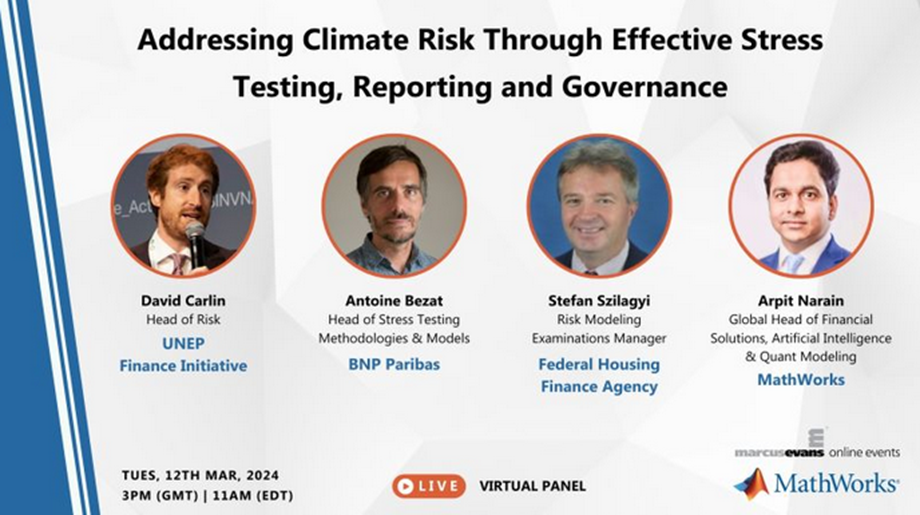Key Insights from our Executive Panel Discussion: Addressing Climate Risk through effective Stress Testing, Reporting, and Governance

Background
In the rapidly evolving landscape of financial risk management, addressing climate risk has emerged as a critical imperative. MathWorks, in collaboration with Marcus Evans, recently hosted an online executive panel discussion on addressing climate risk through effective stress testing, reporting, and governance.
The panel featured a distinguished set of panelists including David Carlin (Head of Risk, United Nations Environment Programme Finance Initiative), Antoine Bezat (Head of Stress Testing Methodologies and Models, BNP Paribas), and Stefan Szilagyi (Risk Modeling Examinations Manager, Federal Housing Finance Agency), and was chaired by Arpit Narain (Global Head of Financial Solutions, MathWorks). The panel collectively explored essential themes surrounding climate risk implementation within financial institutions.
This blog post synthesizes the insights from responses to four pivotal panel questions, encompassing primary use cases, current implementation status, target states for integration, and considerations for tools and technology solutions. It delves into challenges and solutions associated with each aspect, providing comprehensive guidance for navigating the complexities of climate risk management.
Below, we will explore each question addressed in the panel, offering key takeaways and actionable insights for financial institutions navigating the complex terrain of climate risk management.
Key Insights from the Panel Discussion
Question 1: What are the primary climate risk use cases at your organization, highlighting the current state of implementation, target state, and challenges in achieving the target state?
Primary climate risk use cases
Risk management integration: Financial institutions are integrating climate risk into existing risk frameworks, focusing on risk identification, stress testing, capital planning, provisioning, and Internal Capital Adequacy Assessment Process (ICAAP), aligned with risk appetite.
Scenario analysis: Forward-looking scenarios for climate risk impact analysis are critical, aiding in the dynamic assessment of potential future materializations of key variables impacting climate risk. The use of data from the Federal Emergency Management Agency’s (FEMA’s) National Risk Index for Natural Hazards and First Street Foundation for climate exposure analysis was discussed. The importance of downscaling of NGFS scenarios data was also emphasized.
ESG risk assessment: Environmental, Social, and Governance (ESG) considerations are crucial to loan origination and balance sheet oversight, reflecting the importance of integration of sustainability in credit risk analysis.
Regulatory stress testing: Participation in regulatory climate stress tests is a key use case, testing resilience and informing climate risk strategies.
Adaptation and resilience: Financial entities assess and plan for physical and transition risks, adjusting business models and strategies to mitigate impacts from climate-related events and economic shifts toward sustainability.
Current state of implementation
Regulatory and internal stress testing: Since 2019-2020, financial institutions have participated in regulatory stress tests (e.g., Bank of France, European Central Bank) and initiated biannual internal exercises. These actions not only inform their strategic and risk analyses but also contribute to their ICAAP, marking early steps towards integrating climate risk fully.
Voluntary participations: Institutions have also voluntarily participated in additional stress tests (e.g., Stress test mandated by the Hong Kong Monetary Authority for Hong Kong activities), using these regulatory exercises as opportunities to learn, and set milestones in their climate risk roadmap.
Target state
Systematic integration and expansion: The aim is to fully incorporate climate risk into financial planning, focusing on transition risks. Financial institutions aim to widen their analysis to cover various physical risks (like floods, wildfires, droughts) and examine the dynamics between chronic and acute physical risks in more detail.
Challenges and solutions to achieve the target state
Data and methodological limitations: The main issue with climate risk is its forward-looking aspect, which has little historical precedent, complicating the creation of realistic scenarios and precise measurement of physical risks for businesses. Addressing this involves investing in specialized modeling techniques and partnering with academic bodies to enhance these methods.
Knowledge and skills development: A significant knowledge gap exists within institutions regarding climate risk analysis. Upskilling and internal development are crucial for overcoming this barrier, alongside participating in knowledge exchanges with peers and regulators to foster a mutual understanding.
Collaborative efforts for innovation: Tackling the issues of scenario robustness and adverse scenario complexities calls for open collaboration. Solutions include setting up research partnerships with academics and participating in industry-wide talks to make progress.
Technological and regulatory engagement: Technological innovations and active participation in scenario development and stress testing are critical. The challenges of dealing with acute physical risks and the demand for better data and methodologies are recognized, highlighting the ongoing need for improvements in these fields.
Question 2: How can we integrate climate risk analytics into existing strategic risk management and stress testing frameworks?
The need for holistic integration
Integrating climate risk analytics into risk management means combining sustainability data with financial metrics for a full view of a company’s environmental and financial health. This method improves decision-making, making climate disclosures and scenario analyses key to strategic decisions, not just regulatory compliance.
Decision-making in the face of uncertainty
Understanding the uncertainty in climate risk analytics is key, with a focus on improving strategic risk management over mere data accuracy. Using climate risk analytics broadens decision-making by addressing more risk factors, highlighting the need to manage these uncertainties instead of avoiding them.
Conducting “analyst tests”
The framework for integrating climate risk analytics should be thought of as conducting an “analyst’s test”, where the analysts can assess climate risk’s role in financial valuations and investment choices.
Question 3: What are the key stakeholder expectations in climate risk reporting? How can we meet these expectations, and what challenges and solutions are involved?
Key stakeholder expectations
Detailed reporting metrics: Stakeholders, especially regulators, expect comprehensive reporting that includes metrics such as loan-to-value (LTV), FICO scores (including their evolution across different scenarios), debt-to-income ratios, expected annual losses, average annual losses, exceedance probabilities, probability of default, and loss given default. These metrics are crucial for assessing the direct and indirect effects of climate change on credit risk modeling.
Impact on vulnerable communities: There is significant emphasis on understanding and reporting the effects of climate change on vulnerable communities. This expectation extends beyond traditional financial metrics to consider social implications and equity issues, highlighting a broader perspective on climate risk impact.
Meeting the expectations
Integration and audit: Organizations should conduct a thorough sustainability audit of all their operations. This means evaluating how climate risks could affect different departments and roles, ensuring everyone understands their impact and responsibilities clearly.
Focus on use cases: Effective integration of climate risk into decision-making starts with defining specific needs and use cases early on. By focusing first on the precise requirements for climate risk reporting and analysis, organizations can more accurately customize their methods and tools, making sure they are used in a focused and practical way.
Challenges
Alignment across entities: A significant challenge is ensuring consensus among regulated entities about report contents and underlying assumptions for metrics. Differences in interpretations of discount rates, return periods, and modeling assumptions can complicate efforts to standardize and compare reports.
Operational integration: Operationalizing climate risk considerations into everyday business practices presents challenges at the divisional and individual levels. The transition requires clear communication of roles, responsibilities, and expected changes, ensuring that each team and executive understands their part in addressing climate risks.
Solution
Overcoming these challenges necessitates collaboration among stakeholders to agree on standard reporting metrics and assumptions. Additionally, organizations must clearly articulate the operational impacts of climate risk integration, conduct detailed audits, and adapt roles and processes accordingly.
Question 4: What tools and technology solutions should we consider for key climate risk initiatives, and should the focus be on home-grown or externally sourced solutions? What are the challenges in their development and use?
Considerations for tools and technologies
The integration of tools and technology is identified as a crucial strategic focus for embedding climate risk within risk management frameworks. A flexible and effective technological foundation is essential for this integration, highlighting the importance of resilient and adaptable IT development and data systems in managing climate risk.
Build versus buy
Deciding between using external technology or developing it in-house for climate risk analysis requires flexibility and a mix of skills. While primary information might be sourced externally, key aspects such as financial impacts and credit risk analysis require internal development. For physical climate modeling, external resources are often preferred.
Development- and usage-based challenges
Navigating uncertainty with model blending: Handling uncertainty in future outcomes is a major hurdle in climate risk tool development and use. A solution suggests blending models and stress testing to cope with this uncertainty, highlighting the difficulties of precise predictions in climate risks and financial effects.
Integration and interoperability challenges: Integrating external and internal systems smoothly is tough. Good risk management needs these systems to work together well for regular and accurate risk analysis. Understanding how external models can work with internal processes is essential for this to happen.
Pros and cons of homegrown and external solutions: Institutions prefer combining their own solutions with those from outside, seeing the benefits of both. External solutions are widely used and well-tested, while internal ones are flexible and updated quickly. This approach aims to use the strengths of both to effectively manage climate risk.
Key takeaways
To succinctly capture the essence of our panel discussion, here are the key takeaways:
- Strategic Climate Risk Integration: Embedding climate considerations into risk frameworks, focusing on risk identification, stress testing, ESG assessments, and regulatory compliance.
- Forward-looking Scenarios: Utilizing forward-looking scenarios for dynamic risk assessment, emphasizing resilience and sustainability planning.
- Data and Modeling Challenges: Addressing data limitations and advancing modeling techniques through technology investments and industry and academic collaboration.
- Holistic Decision-Making: Combining sustainability data with financial metrics for informed decision-making, meeting stakeholder expectations for risk reporting.
- Innovation in Uncertainty Management: Employing model blending, stress testing, and developing both internal and external solutions to navigate climate risk uncertainties.
Call to action
As we continue to deal with the complexities of climate risk & ESG, MathWorks is committed to playing a pivotal role in developing innovative solutions and strategies. Our dedicated team is focused on leveraging advanced analytics and modeling tools to better understand and mitigate climate-related risks. The details of MathWorks’ Climate Risk & ESG offerings can be found here.
For more information about our initiatives or to discuss potential collaborations, please feel free to contact Arpit Narain (anarain@mathworks.com).
- 범주:
- Climate Finance









댓글
댓글을 남기려면 링크 를 클릭하여 MathWorks 계정에 로그인하거나 계정을 새로 만드십시오.